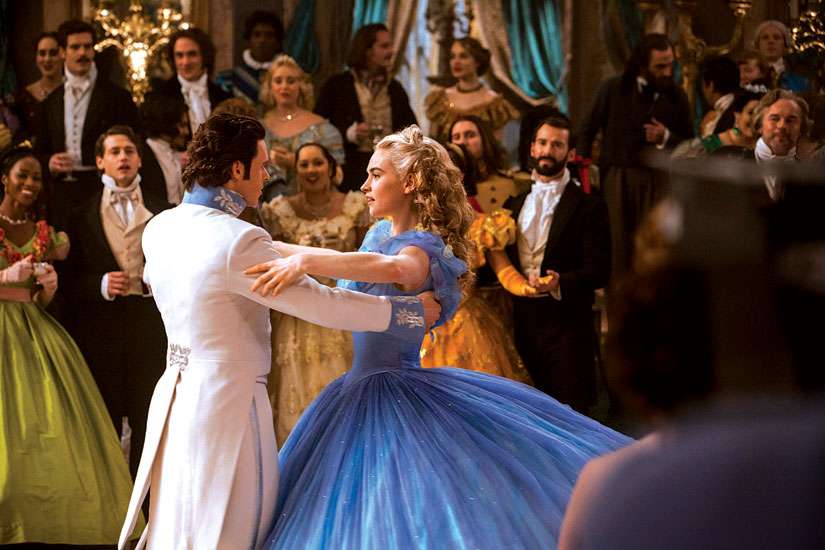I say this because director Kenneth Branagh manages to tell the familiar fairy tale without irony, hyper-feminist sub-plots, Marxist insinuations, cynicism or condescension. In so doing, he actually allows the spiritual, indeed specifically Christian, character of the tale to emerge.
I realize that it probably strikes a contemporary audience as odd that Cinderella might be a Christian allegory, but keep in mind that most of the fairytales and children’s stories compiled by the Brothers Grimm and later adapted by Walt Disney found their roots in the decidedly Christian culture of late medieval and early modern Europe.
In Branagh’s telling, Ella was the daughter of wonderful parents who instilled in her a keen sense of moral virtue and joie de vivre. The girl’s idyllic childhood was interrupted by the sudden illness of her mother, who, on her death bed, told Ella always to be “kind and courageous.” Her father remarried and brought his new wife and her two daughters to live with him and Ella.
Some years later, Ella’s father left on a lengthy business trip. A few weeks later, a servant arrived with the dreadful news that
Ella’s father had become sick and died.
The now utterly isolated Ella became the victim of her wicked stepmother (played by the always compelling Cate Blanchett) and her obnoxious stepsisters, who visit upon her every type of cruelty and injustice. Significantly, the cat belonging to Ella’s stepfamily is called Lucifer.
So we have a beautiful, vivacious and morally upright young lady whose life becomes a nightmare through the intervention of untimely death and wicked oppression. So thorough was her loss of dignity that she found herself covered in dust, her beauty obscured.
It does not require a huge leap of imagination to see this as an allegory of the fall of the human race. God created us as beautiful, indeed in His own image and likeness, but through sin and the ministrations of the devil, we descended into dysfunction, and our beauty was covered over. In the technical language of theologians, although we had kept the image of God, we had lost our likeness to Him.
In Branagh’s traditional telling of the Cinderella tale, while out riding in the country Cinderella encountered a magnificent stag that was being pursued by a hunting party. Subsequently, she met the leader of the hunting brigade, a handsome young prince, the son of the king. The two almost immediately fell in love. Because she returned home without identifying herself, the prince called for a ball and invited all of the young women of the realm to come, hoping to lure his mysterious beloved.
Though her stepfamily tried desperately to prevent her from attending, Cinderella, through the ministrations of her fairy godmother, managed to attend the ball, where she entranced the prince. Once again, she was compelled to leave early, and the lovesick prince sought her desperately until he found her and married her.
We are tempted, no doubt, to see all of this as the stuff of ordinary romance, but we should look more deeply. First, the stag is a traditional sign of Christ and thus His presence as the object of the hunt is meant to signal His presence at the symbolic level of the narrative. Moreover, the prince, the son of the king, who falls in love with a woman despite her lowliness, is an obvious evocation of Jesus, the Son of God, who was sent to become the bridegroom of a human race whose spiritual beauty had been covered over by sin.
The prophet Isaiah predicted that the “builder of the human race” would come one day to marry His people. The motif of the sacred marriage runs right through the New Testament. Indeed, the fathers of the Church took particular delight in ringing the changes on this theme, emphasizing that the Prince of Peace, the Son of God, in marrying the human race lifted us up out of our lowliness and bestowed upon us all of His own benefits and dignity.
In the symbolic language of our story, the unmerited love of the prince indeed transformed Cinderella into a princess.
The surest sign that this transformation has occurred — and it is one of my favourite elements in Branagh’s telling — is that Cinderella, upon escaping from the cruel oppression of her stepmother, turned to the wicked woman, not to curse her, but to offer a word of forgiveness. There could be no more compelling proof that she had thoroughly taken on the character of the bridegroom.
If you see this film, as you take in the fantasy and romance of it, try also to appreciate it as a deeply Christian story.
(Fr. Barron is the founder of the global ministry, Word on Fire, and the Rector/President of Mundelein Seminary near Chicago.)

